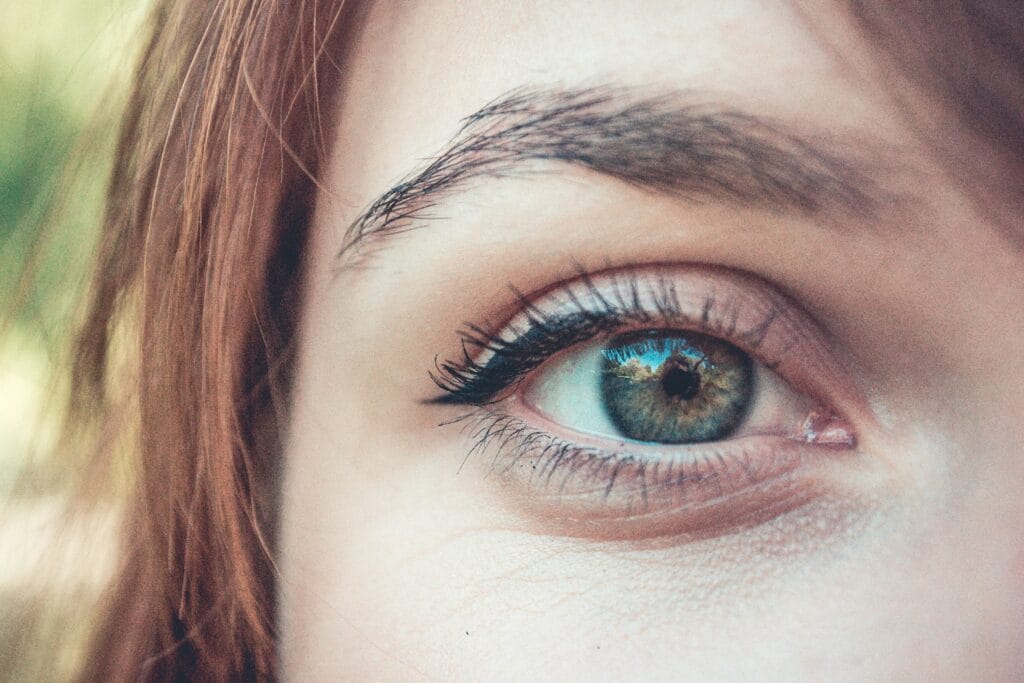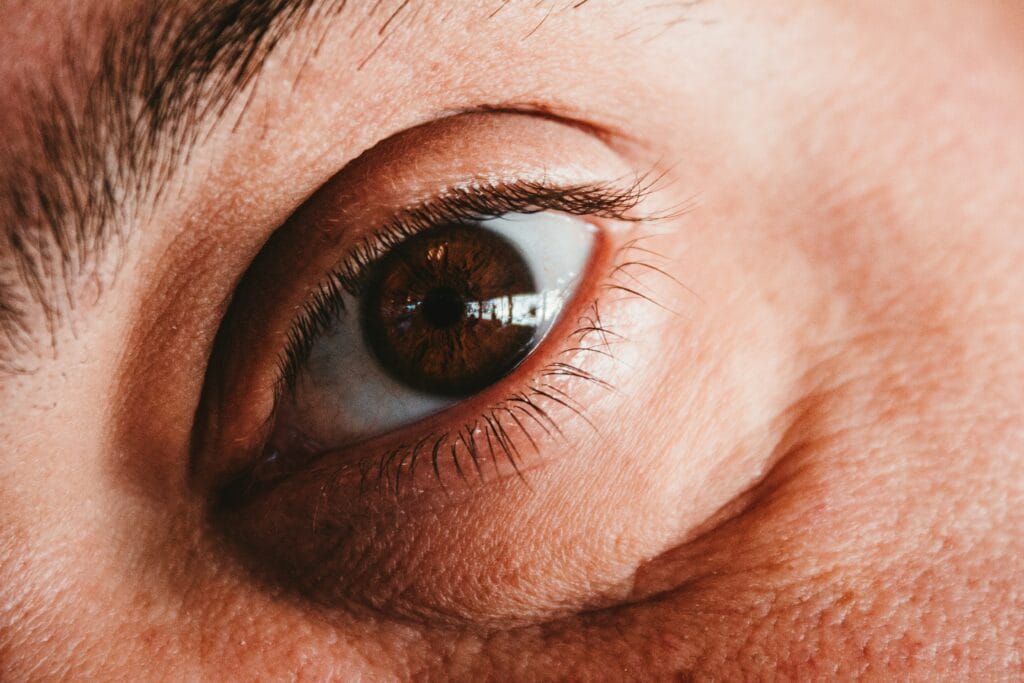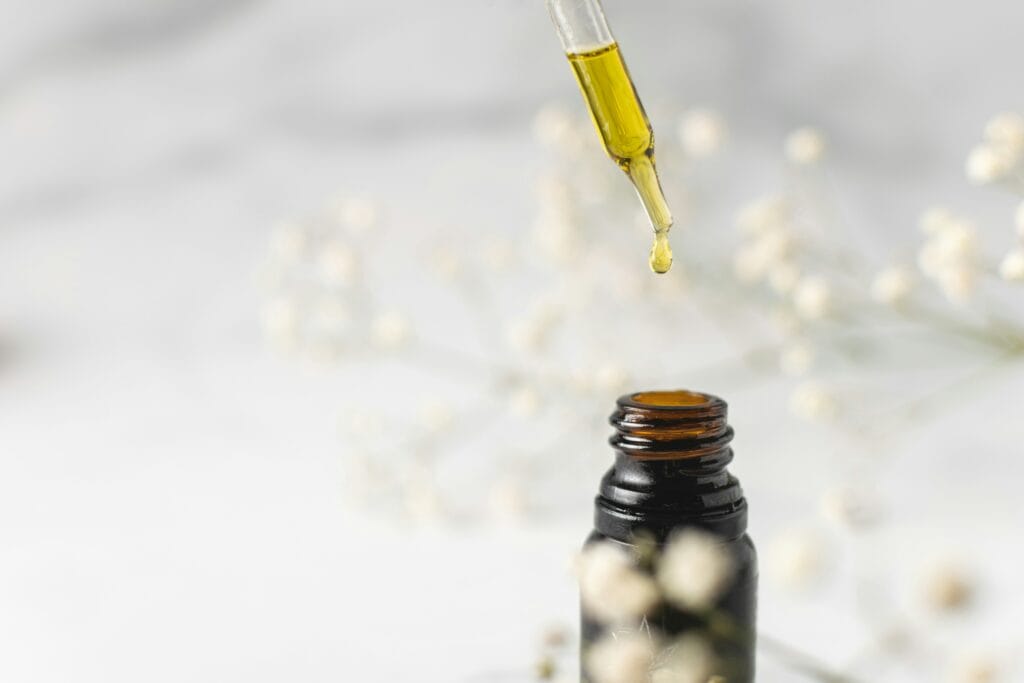Why eyebrows thin during perimenopause
As oestrogen and progesterone fluctuate, the growth (anagen) phase of eyebrow hairs often shortens. Hairs shed sooner, regrow more slowly and may feel finer. Common co-factors—stress, poor sleep, low iron or thyroid changes, over-tweezing, and strong skincare acids/retinoids across the brow line—can compound thinning.
The reassuring news: most people see a visible improvement with gentle, consistent care over 8–12 weeks.

The 12-week eyebrow growth plan
Weeks 1–4: Reset and protect
- Hands off: Pause waxing/threading; only trim strays.
- Gentle cleanse: Non-stripping cleanser; pat brows dry.
- Nightly serum: Start a peptide-based brow serum (see shortlist below). Apply to clean, dry skin and let it set before moisturiser.
- Light seal (optional): A tiny slick of squalane or castor oil over the hairs can reduce breakage.
- SPF around brows: Protect the skin above/below the brow; avoid saturating hairs with heavy sunscreen.
- Skincare detour: Keep retinoids and strong acids away from the brow area.
- Nutrition basics: Protein with every meal; iron-rich foods (beans, eggs, leafy greens); zinc and omega-3 sources (seeds, nuts, oily fish).
Weeks 5–8: Stimulate and strengthen
- Spoolie massage: 30–60 seconds of gentle brushing each night to distribute natural oils and lightly stimulate the area.
- Consistency beats intensity: Keep serum nightly.
- Lifestyle levers: Prioritise sleep and simple stress tools (walks, breathwork); high stress hormones can slow hair growth.
- Smart styling: Use tint or fibre gel for instant fullness; choose light, hair-like pencil strokes rather than heavy blocks.
Weeks 9–12: Review and refine
- Progress photos: Compare Week 0 vs Week 10–12 in similar lighting. Look for density at the head and tail, and healthier texture.
- Still patchy? Consider professional brow tinting or, if desired, a microblading consultation (check credentials and healed results).
- Check health factors: If progress is minimal, speak to a GP about iron, thyroid and vitamin D. Discuss prescription options if appropriate.
Serum shortlist (UK): peptide-first picks

Usage tips: apply to clean, dry brows; a thin swipe along hairs/skin once nightly (some brands recommend twice daily). Patch-test first and avoid getting product in the eyes.
- Budget | The Ordinary Multi-Peptide Lash & Brow Serum (15 ml)
Multi-peptide complexes with panthenol. Designed for frequent use and well suited to sensitive routines. - Mid | RapidBrow® Eyebrow Enhancing Serum (3 ml)
“Hexatein® 2” blend (polypeptides, biotin, panthenol, botanical extracts). Typically used twice daily for the first 8 weeks, then maintain. - Premium | RevitaBrow® Advanced Eyebrow Conditioner (1.5–3 ml)
Conditioning focus for brittle, ageing brows. Once daily. Emphasises flexibility/shine and reduced breakage. - Premium | GrandeBROW Brow Enhancing Serum (4-month supply)
Conditioning formula featuring humectants and amino acids; once daily, with results expected over several months.
Why peptide-based? These formulas aim to condition hairs and support the look of density with a lower irritation profile than prostaglandin-analogue products for many users. Expect subtle, steady gains rather than dramatic overnight change.
A careful word on prostaglandin-analogue serums
Some lash/brow products include prostaglandin analogues (ingredients often ending in “-prost”). They can be effective but may cause irritation or pigment changes in some users. If considering these—or minoxidil anywhere near the eye area—seek medical advice first.
Everyday habits that help (and what to avoid)

Do:
- Keep brows clean and gently brushed.
- Use a peptide serum consistently.
- Protect surrounding skin from UV.
- Eat protein-rich meals and iron/zinc/omega-3 sources.
Avoid:
- Over-tweezing or frequent waxing while growing out.
- Scrubbing the brow area with AHAs/BHAs/retinoids.
- Heavy tugging with stiff pencils or brushes.
- Sleeping in makeup.
Nutrition pointers (food-first)
Eyebrow hairs are keratin, which relies on adequate protein and micronutrients. Build meals around:
- Protein: eggs, yoghurt, tofu, chicken, beans, lentils.
- Iron: lentils, spinach, fortified cereals—pair with vitamin C for absorption.
- Zinc: chickpeas, seeds, seafood.
- Omega-3: salmon, mackerel, chia or flax.
Discuss vitamin D testing with a GP if winter-low; supplement only on professional advice.
Fast fullness: safer styling cheats
- Tint: Darkens fair hairs instantly (patch test; use a qualified technician).
- Fibre gels: Add believable volume without tugging.
- Pencil + micro-pen: Soft pencil for structure; micro-tip pen for hair-like strokes.
- Brow lamination: Can lift fine hairs; choose experienced practitioners and follow gentle aftercare.
- Microblading (semi-permanent): Research artists carefully; review healed results and hygiene protocols.
FAQs (quick answers)

How long until I see change?
Most notice healthier, fuller-looking brows within 8–12 weeks with consistent habits; full cycles can take longer.
Are serums “growth” products?
Peptide serums primarily condition and support the appearance of density. Prescription options exist—discuss suitability with a clinician.
Is castor oil proven?
Evidence for growth is limited, but it can help reduce breakage and add gloss. Use sparingly over hairs, not into eyes.
Can HRT help?
Some report hair benefits with well-managed HRT, but responses vary. Seek medical guidance.
The saveable 7-step routine

- Gentle cleanse; pat dry
- Nightly peptide brow serum
- Tiny occlusive if tolerated
- SPF around (not into) brows
- Spoolie massage nightly
- Protein/iron-forward meals
- Tint/fibre gel for instant fullness
Friendly reminder
This guide is for information only and not medical advice. Seek professional care for sudden or patchy loss, itching or inflammation, or before using prescription products.

